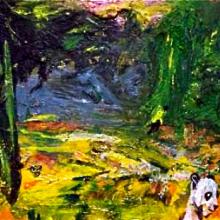
A lecturer at Edinburgh College of Art, Derek McGuire will be exhibiting in Broughton Street's Union Gallery later this month in what promises to be an atmospheric collection ideally suited to the shortening autumn days and changing light.
'Ella Novo Loco', named after the new place in which McGuire finds himself, will run from 10 September.
'His paintings are dark not only in terms of the palette, but also in the spookiness of their moods,' writes Alison Auldjo, Union's co-owner.
'When other colours brighten them – lurid pinks, warm yellows or infected greens – they take on a neon, plastic or toxic light.'
She describes him as a painter of extraordinary depth and diversity, whose work is strongly improvisational as it plays between figurative and abstract elements.
Born in Cowdenbeath in 1964, McGuire graduated from Edinburgh College of Art in 1986, and afterwards won scholarships to Yale and Australia. He has exhibited widely, and was until recently teaching at Tallin University in Estonia.
Of his own work he writes: 'Painting allows me to show combinations that may not exist in the world, to create imagery out of thin air, to imagine possibilities and suggestions.
'I play with the paint to find meaning, trying to fathom out the connections between my image, surface and technique. Each work is a performance which may or may not come off. It’s a method of chance, risk and edginess [...] There can be a sense of melancholy and sometimes menace or danger.
'I hope to question the audience with my view of life, complete with its nervousness, anxieties and sorrows.'
To see more of McGuire's work, click here. To find out more, go along to his free (and informal) talk at the Union Gallery on Saturday 18 September, 3:00pm.
The paintings shown on this page are (top) The Relaxing Pleasure of Shitting in the Woods (oil and enamel on canvas) and (below) The Rears of the Charging Chasseurs (oil, beeswax and enamel on board). Both titles suggest that, in addition to any gloomy qualities it may have, his work also contains an element of bleak or oblique humour.
[img_assist|nid=1064|title=|desc=|link=node|align=center|width=640|height=453]